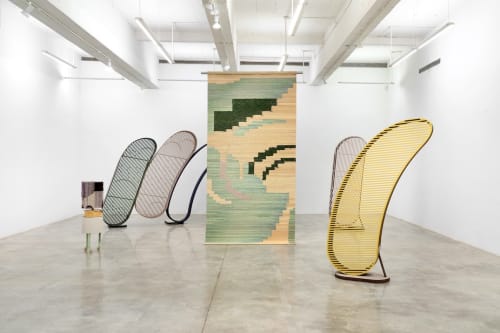Currently on view at Tina Kim Gallery in New York is Suki Seokyeong Kangpresenting her latest self-titled solo exhibition. The show, open through June 15, 2024, features pieces from her 2023 major exhibition at Seoul’s Leeum Museum of Art, “Willow Drum Oriole.”
Traditional Inspirations With Innovative Spins
Traditional influences, particularly in the realm of historical song and dance, lay the foundation for Suki Seokyeong Kang’s artistic pursuits. Trained in traditional Eastern painting techniques, including Oriental Painting at Korea’s Ewha Womans University, Kang derives her current contemporary eye from a rich background of cultural curiosity. As seen throughout the Tina Kim show, Kang takes these century-old inspirations and adds a unique personal flair that merges with the current art sphere.
The Jeongganbo and Grids
A constant symbol at the basis of Kang’s work and recurring style is Jeongganbo, the first musical notation system from East Asia dating back to Joseon Dynasty Korea. Jeongganbo insignias are inscribed as grid-like emblems, and for Kang, have served as constant inspiration for her artistic endeavors and patterns. Grids and squares, therefore, are sustained occurrences throughout the exhibit as Kang’s creations toy with the fine line between stability and fluidity.
This playfulness with Jeongganbo imagery is particularly notable in the painting Jeong, a part of the larger series that received its own focused solo exhibition at Tina Kim in 2018. The “Jeong” series explores the balance between the static and fluid: with her traditional painting background, Kang plays with variations of the classical grid form through the layering of paint and hollowed canvas to add an abstract spin. Every drip of traditional paint, while the painting’s lines may seem carefree and loosely placed, is meticulously layered on top of one another to create harmonious, but not rigid, square units.
In alignment with her musical inspiration, Kang’s pieces draw from traditional Korean dance choreography and its suggested commentary on an individuals’ position in space. A particular source of inspiration is the Hwamunseok, a traditional mat used for a classical Joseon dynasty Chunaengmu court dance, also known as the Dance of the Spring Oriole. This mat served as the sole way for individuals to interact with royal court members, however, they remained confined to the small perimeter of their mats.
Kang’s “Mat” and more recent “Mat Black Mat” series question what defines an individual’s position in a broader context: what keeps them there? The mat can be used as a stage for a performance, designating them a place to stand, but also restricts their flexibility to leave that given space.
Hanging 12.5 feet tall in the second gallery room, the Mat Black Mat installation further depicts Kang’s exquisite craftsmanship. The artist worked alongside female traditional weavers to acknowledge their historically under-appreciated talents, and visitors are able to circle around the mat in its entirety, giving them the chance to take note of each individual stitch. This mat is a dyed and reworked Hwamunseok with a more formal geometric design: a melange of classical and contemporary.
In addition to her musical influences, Kang pays homage to other forms of Korean artistry like late Joseon dynasty concepts of “true-view” art. The notion stemmed from prominent 18th-century painter Jeong Seon’s abandonment of idealized landscapes in favor of realistic imagery. Instead of painting unrealistic mountains they had never seen, Seon urged, painters should instead depict the mist-covered Mount Inwang.
Kang’s three-dimensional “Mountain” series uplifts these true-view concepts in an abstract manner, as viewers can wander around four mountainous structures that represent the four seasons. Each individual mountain summons a specific season, as Kang reinvents traditional landscape painting with her interactive sculptures.
In Mountain – summer, its two gracefully rounded metal arches face two opposite directions, like a weighing scale, but ultimately the two curvatures foster a sense of equilibrium. With its contrast of geometric metal, organic shape, soft color, and woven elements, Kang’s “Mountain” series further contributes to the collection’s balanced nature.
In addition to her “Jeong,” “Mat,” and “Mountain” series, Kang’s unique artistic direction manifests in additional references to musical grid notations in her new moveable “Column” series and references to Korean linguistic labels for phonological units in her beautifully layered “Mora” paintings.
The artist’s oeuvre brims with juxtapositions: fragile yet steady structures, use of metal with free organic shapes, and pieces that lean away from each other in opposite directions. With her piece Narrow Meadow, Suki Seokyeong Kang assembles solid-appearing materials into a precariously balanced sculpture that could topple with the tap of a hand. Among all this contrast, however, its varying tensions merge together in harmony, and while abstract, further address how individuals are constricted and kept in their spaces.
—HARRIET ENGELKE


